As adeep tissue massage therapistand movement coach, I do not solely treat the local area of a client's complaint; I address the structure of the whole body. I look fordysfunctional fascial tissueand assess the underlying postural movement patterns that cause them. By addressing the underlying problem, proper movement patterns can be developed, preventing pain and injury over a lifetime. Over the years I have noticed very commonfascial pain patternsin almost all of my clients. I have traced these pain patterns through their hips, knees, and feet and finally to the shoes that they wear.
I have studied the mechanics of walking and running and have myself been a full time barefoot/minimalist runner for several years. In my closet are a few pairs of these minimalist shoes, includingvibram five finger shoesandsoft star shoes. In studying walking and running mechanics, I have noticed that most articles about gait pattern, both shod and barefoot specific, examine the body in linear movement, or a straight line. This view is very limiting in the fact that there are multiple forces taking place in the body at all times, especially during running and walking.
The movement forces I notice most often in my massage and coaching work are rotation and compression. It is the combination of these two forces that are most destructive to the soft tissue of the hip, knee, ankle, and foot. It is my belief that the combination of structural support in shoes and a heel strike gait pattern reinforce poor walking and running mechanics, leading to an increase in rotational and compressive forces in the leg which ultimately contribute tochronic pain and injurythroughout the body. The design of the foot is such that with a forefoot strike gait pattern rotational forces are lessened through the upper leg which will lead to lower incidence of chronic pain and injury over one's lifespan.
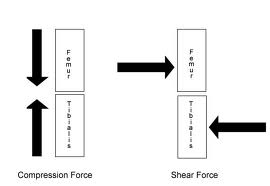
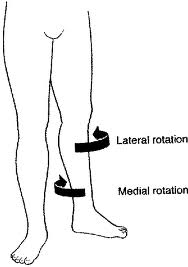
The following is my theory on both walking and running gait patterns of forefoot strike compared to heelstrike and how it relates to pain and injury.
The Bare Foot and Forefoot Strike
There are 28 bones and more than 30 joints in the foot. Bones, muscles, tendons, ligaments and fascial tissue create the three arches of your foot (medial, longitudinal, and transverse) which aid in weight bearing, stabilization, and propulsion. When engaged, the arches of the foot act like a loaded spring. As the forefoot comes in contact with the ground, impact force is loaded into the natural spring mechanism of the arches. As the foot leaves contact with the ground, the energy absorbed by the arches is released through the ground providing additional mechanical advantage. “This kind of collision produces a very low rise in force. There is essentially no impact.“Daniel Lieberman et al.
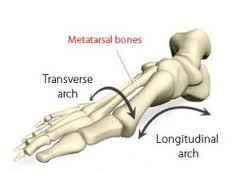 When walking or running, as the forefoot comes into contact with the ground it flattens and creates an agile, flexible base platform. Rotational forces transfer through the arches from the outside to the inside of the forefoot (little toe to big toe), followed by push off through the big toe. This rotational force is absorbed fully into the arches which stabilizes the foot, knee and hip with each footfall. By absorbing rotational forces at the foot, rotation is prevented in the knee and hips.
When walking or running, as the forefoot comes into contact with the ground it flattens and creates an agile, flexible base platform. Rotational forces transfer through the arches from the outside to the inside of the forefoot (little toe to big toe), followed by push off through the big toe. This rotational force is absorbed fully into the arches which stabilizes the foot, knee and hip with each footfall. By absorbing rotational forces at the foot, rotation is prevented in the knee and hips.
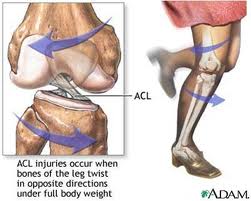
With forefoot strike your foot is less likely to roll to one side or the other, keeping the knee and hip stable with minimal outward and inward rotation. This places less stress and wear and tear upon the knee joint, and your ankle is kept in a structurally stable position preventing an ankle twist.
Everything changes once you put shoes on your feet. The combination of a heel wedge, structural arch support, and cushioning, in the majority of shoes on the market today, promotes an unnatural gait pattern… heel strike.
“We have seen the height as well as the cushion gradually increase which inadvertently hassles many runners to adopt a “heel to toe” gait or “heel strike” when running. This design encourages an unnatural gait resulting in the heel hitting the ground first, followed by a rapid “slapping” of the forefoot.”Dr. Nicholas A Campitelli
What Happens in Your Shoes with Heel Strike
The heel of the foot is the hardest bone in the body. It is not cushioned and does not absorb impact well. The impact force at the foot combined with the downward gravitational force of the body creates compression throughout the joints of the skeletal system. When you heel strike, your foot comes to a sudden, violent stop–it is the equivalent of slamming on the brakes with every single step. Impact forces between 1.5 up to 3 times your body weight go through the heel, leg, hip, shoulder, and neck. This kind of collision leads to a high impact and is the equivalent of being hit on the heel with a hammer using 1.5 to 3 times your body weight between 1000-1500 times per mile.
impact force at the foot combined with the downward gravitational force of the body creates compression throughout the joints of the skeletal system. When you heel strike, your foot comes to a sudden, violent stop–it is the equivalent of slamming on the brakes with every single step. Impact forces between 1.5 up to 3 times your body weight go through the heel, leg, hip, shoulder, and neck. This kind of collision leads to a high impact and is the equivalent of being hit on the heel with a hammer using 1.5 to 3 times your body weight between 1000-1500 times per mile.
“We have found that even on hard surfaces (a steel force plate) runners who forefoot strike have impact forces that are 7 times lower than shod runners who heel strike. Rates of loading are equal to or less than rates of loading for shod runners.”Daniel Lieberman et al.
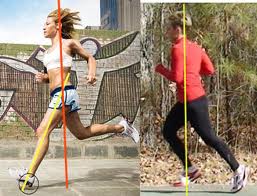 “In heel striking, the collision of the heel with the ground generates a significantly large, nearly instantaneous force. This force sends a shock wave up through the body via the skeletal system.”Daniel Lieberman et al.
“In heel striking, the collision of the heel with the ground generates a significantly large, nearly instantaneous force. This force sends a shock wave up through the body via the skeletal system.”Daniel Lieberman et al.
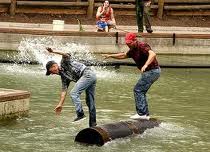 The bone of the heel is round, making it an unstable surface which is susceptible to roll either along the inside or outside edge of the foot; imagine walking on a log in the water. The direction the foot rolls after heel strike is dependent upon the muscular imbalances in the upper leg. Most runners and walkers have muscular dominance on the outside of their leg, causing the foot to roll along the outside edge – supination – when the heel strikes the ground. With shoes, the added height of the cushioning and heel wedge places the foot in an unstable position and at an increased risk of twisting the ankle.
The bone of the heel is round, making it an unstable surface which is susceptible to roll either along the inside or outside edge of the foot; imagine walking on a log in the water. The direction the foot rolls after heel strike is dependent upon the muscular imbalances in the upper leg. Most runners and walkers have muscular dominance on the outside of their leg, causing the foot to roll along the outside edge – supination – when the heel strikes the ground. With shoes, the added height of the cushioning and heel wedge places the foot in an unstable position and at an increased risk of twisting the ankle.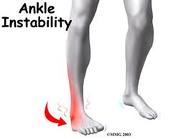
What happens at the foot affects the movement at the knees. As the foot rolls along it's outside edge, the knee rotates externally. The load then moves from the little toe to the big toe for push off, but since the foot is braced by the structural arch support of shoes, it cannot naturally absorb this rotational load into the arch, as it does when one is barefoot. Instead, the knee must violently rotate inwardly to forcibly press the big toe into the ground. This is at the very same time that downward compressive force is greatest through the body. What this means is that each time your foot hits the ground, with 1.5 to 3 times your body weight in compressive force, your knee is turning like a cork screw–rotational force. It is this rotation at the knee combined with downward compression that places the hip, knee, and foot at increased risk of soft tissue damage ultimately leading tochronic pain and injury. The knee is a hinge joint, similar to the the hinges of a door. It is designed to move in two directions, forward and backwards. It is not designed for rotation. Imagine if every time you opened and closed your kitchen cabinet door, you hung on it with your full body weight. After prolonged activity, what would happen to the door hinge?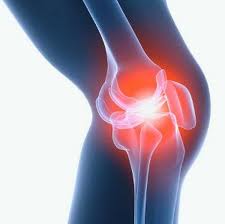 Everything in the body is connectedImpact through the foot has an affect on the all tissues throughout the body. If you are walking or running with an improper gait, you will feel it instantaneously at your foot as pain. This allows you to make immediate adjustments in your walking or running stride. The cushion and structural support of shoes creates a disconnect from this instantaneous feedback system. You are no longer able to feel the discomfort at your foot, allowing you to continue to move with a dysfunctional gait pattern. Over time, walking mile after mile with improper form your knee, hip, back, shoulder or neck hurt, but by this point you are completely disconnected from the original source of the problem – how your foot strikes the ground with each step.
Everything in the body is connectedImpact through the foot has an affect on the all tissues throughout the body. If you are walking or running with an improper gait, you will feel it instantaneously at your foot as pain. This allows you to make immediate adjustments in your walking or running stride. The cushion and structural support of shoes creates a disconnect from this instantaneous feedback system. You are no longer able to feel the discomfort at your foot, allowing you to continue to move with a dysfunctional gait pattern. Over time, walking mile after mile with improper form your knee, hip, back, shoulder or neck hurt, but by this point you are completely disconnected from the original source of the problem – how your foot strikes the ground with each step.
As adeep tissue massage therapistand movement coach, I specialize in treatingchronic pain and injury. Over the years I have successfully treated injuries such asplantar fasciitis,sciatic or piriformis pain,frozen shoulder, back pain, and more. In all of these painful conditions, I have found a strong connection between the occurrence of injury, and the rotation and compression forces caused by heel strike and shoes, with runners and non-runners alike.
It is my opinion that if you strengthen your feet, legs, and hips; slowly transition to minimalist shoes (click here to read more about how I define minimalist shoes); and re-train your body to walk, run, and move with a forefoot strike gait pattern, you will prevent long term chronic pain and injury throughout your life. I recommend beginning aself care program of self-myofascial release using a foam roller; receiving regulardeep tissue massagefrom a highly qualified and experienced licenced massage therapist who understands thefascial system's connection to pain and injury; and receiving personal coaching from a barefoot/minimalist running/walking coach.
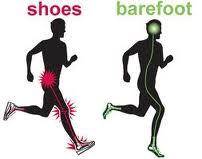
I have studied the mechanics of walking and running and have myself been a full time barefoot/minimalist runner for several years. In my closet are a few pairs of these minimalist shoes, includingvibram five finger shoesandsoft star shoes. In studying walking and running mechanics, I have noticed that most articles about gait pattern, both shod and barefoot specific, examine the body in linear movement, or a straight line. This view is very limiting in the fact that there are multiple forces taking place in the body at all times, especially during running and walking.
The movement forces I notice most often in my massage and coaching work are rotation and compression. It is the combination of these two forces that are most destructive to the soft tissue of the hip, knee, ankle, and foot. It is my belief that the combination of structural support in shoes and a heel strike gait pattern reinforce poor walking and running mechanics, leading to an increase in rotational and compressive forces in the leg which ultimately contribute tochronic pain and injurythroughout the body. The design of the foot is such that with a forefoot strike gait pattern rotational forces are lessened through the upper leg which will lead to lower incidence of chronic pain and injury over one's lifespan.


The following is my theory on both walking and running gait patterns of forefoot strike compared to heelstrike and how it relates to pain and injury.
The Bare Foot and Forefoot Strike
There are 28 bones and more than 30 joints in the foot. Bones, muscles, tendons, ligaments and fascial tissue create the three arches of your foot (medial, longitudinal, and transverse) which aid in weight bearing, stabilization, and propulsion. When engaged, the arches of the foot act like a loaded spring. As the forefoot comes in contact with the ground, impact force is loaded into the natural spring mechanism of the arches. As the foot leaves contact with the ground, the energy absorbed by the arches is released through the ground providing additional mechanical advantage. “This kind of collision produces a very low rise in force. There is essentially no impact.“Daniel Lieberman et al.
 When walking or running, as the forefoot comes into contact with the ground it flattens and creates an agile, flexible base platform. Rotational forces transfer through the arches from the outside to the inside of the forefoot (little toe to big toe), followed by push off through the big toe. This rotational force is absorbed fully into the arches which stabilizes the foot, knee and hip with each footfall. By absorbing rotational forces at the foot, rotation is prevented in the knee and hips.
When walking or running, as the forefoot comes into contact with the ground it flattens and creates an agile, flexible base platform. Rotational forces transfer through the arches from the outside to the inside of the forefoot (little toe to big toe), followed by push off through the big toe. This rotational force is absorbed fully into the arches which stabilizes the foot, knee and hip with each footfall. By absorbing rotational forces at the foot, rotation is prevented in the knee and hips.
With forefoot strike your foot is less likely to roll to one side or the other, keeping the knee and hip stable with minimal outward and inward rotation. This places less stress and wear and tear upon the knee joint, and your ankle is kept in a structurally stable position preventing an ankle twist.
Everything changes once you put shoes on your feet. The combination of a heel wedge, structural arch support, and cushioning, in the majority of shoes on the market today, promotes an unnatural gait pattern… heel strike.
“We have seen the height as well as the cushion gradually increase which inadvertently hassles many runners to adopt a “heel to toe” gait or “heel strike” when running. This design encourages an unnatural gait resulting in the heel hitting the ground first, followed by a rapid “slapping” of the forefoot.”Dr. Nicholas A Campitelli
What Happens in Your Shoes with Heel Strike
The heel of the foot is the hardest bone in the body. It is not cushioned and does not absorb impact well. The
 impact force at the foot combined with the downward gravitational force of the body creates compression throughout the joints of the skeletal system. When you heel strike, your foot comes to a sudden, violent stop–it is the equivalent of slamming on the brakes with every single step. Impact forces between 1.5 up to 3 times your body weight go through the heel, leg, hip, shoulder, and neck. This kind of collision leads to a high impact and is the equivalent of being hit on the heel with a hammer using 1.5 to 3 times your body weight between 1000-1500 times per mile.
impact force at the foot combined with the downward gravitational force of the body creates compression throughout the joints of the skeletal system. When you heel strike, your foot comes to a sudden, violent stop–it is the equivalent of slamming on the brakes with every single step. Impact forces between 1.5 up to 3 times your body weight go through the heel, leg, hip, shoulder, and neck. This kind of collision leads to a high impact and is the equivalent of being hit on the heel with a hammer using 1.5 to 3 times your body weight between 1000-1500 times per mile.“We have found that even on hard surfaces (a steel force plate) runners who forefoot strike have impact forces that are 7 times lower than shod runners who heel strike. Rates of loading are equal to or less than rates of loading for shod runners.”Daniel Lieberman et al.
 “In heel striking, the collision of the heel with the ground generates a significantly large, nearly instantaneous force. This force sends a shock wave up through the body via the skeletal system.”Daniel Lieberman et al.
“In heel striking, the collision of the heel with the ground generates a significantly large, nearly instantaneous force. This force sends a shock wave up through the body via the skeletal system.”Daniel Lieberman et al. The bone of the heel is round, making it an unstable surface which is susceptible to roll either along the inside or outside edge of the foot; imagine walking on a log in the water. The direction the foot rolls after heel strike is dependent upon the muscular imbalances in the upper leg. Most runners and walkers have muscular dominance on the outside of their leg, causing the foot to roll along the outside edge – supination – when the heel strikes the ground. With shoes, the added height of the cushioning and heel wedge places the foot in an unstable position and at an increased risk of twisting the ankle.
The bone of the heel is round, making it an unstable surface which is susceptible to roll either along the inside or outside edge of the foot; imagine walking on a log in the water. The direction the foot rolls after heel strike is dependent upon the muscular imbalances in the upper leg. Most runners and walkers have muscular dominance on the outside of their leg, causing the foot to roll along the outside edge – supination – when the heel strikes the ground. With shoes, the added height of the cushioning and heel wedge places the foot in an unstable position and at an increased risk of twisting the ankle.
What happens at the foot affects the movement at the knees. As the foot rolls along it's outside edge, the knee rotates externally. The load then moves from the little toe to the big toe for push off, but since the foot is braced by the structural arch support of shoes, it cannot naturally absorb this rotational load into the arch, as it does when one is barefoot. Instead, the knee must violently rotate inwardly to forcibly press the big toe into the ground. This is at the very same time that downward compressive force is greatest through the body. What this means is that each time your foot hits the ground, with 1.5 to 3 times your body weight in compressive force, your knee is turning like a cork screw–rotational force. It is this rotation at the knee combined with downward compression that places the hip, knee, and foot at increased risk of soft tissue damage ultimately leading tochronic pain and injury. The knee is a hinge joint, similar to the the hinges of a door. It is designed to move in two directions, forward and backwards. It is not designed for rotation. Imagine if every time you opened and closed your kitchen cabinet door, you hung on it with your full body weight. After prolonged activity, what would happen to the door hinge?
 Everything in the body is connectedImpact through the foot has an affect on the all tissues throughout the body. If you are walking or running with an improper gait, you will feel it instantaneously at your foot as pain. This allows you to make immediate adjustments in your walking or running stride. The cushion and structural support of shoes creates a disconnect from this instantaneous feedback system. You are no longer able to feel the discomfort at your foot, allowing you to continue to move with a dysfunctional gait pattern. Over time, walking mile after mile with improper form your knee, hip, back, shoulder or neck hurt, but by this point you are completely disconnected from the original source of the problem – how your foot strikes the ground with each step.
Everything in the body is connectedImpact through the foot has an affect on the all tissues throughout the body. If you are walking or running with an improper gait, you will feel it instantaneously at your foot as pain. This allows you to make immediate adjustments in your walking or running stride. The cushion and structural support of shoes creates a disconnect from this instantaneous feedback system. You are no longer able to feel the discomfort at your foot, allowing you to continue to move with a dysfunctional gait pattern. Over time, walking mile after mile with improper form your knee, hip, back, shoulder or neck hurt, but by this point you are completely disconnected from the original source of the problem – how your foot strikes the ground with each step.As adeep tissue massage therapistand movement coach, I specialize in treatingchronic pain and injury. Over the years I have successfully treated injuries such asplantar fasciitis,sciatic or piriformis pain,frozen shoulder, back pain, and more. In all of these painful conditions, I have found a strong connection between the occurrence of injury, and the rotation and compression forces caused by heel strike and shoes, with runners and non-runners alike.
It is my opinion that if you strengthen your feet, legs, and hips; slowly transition to minimalist shoes (click here to read more about how I define minimalist shoes); and re-train your body to walk, run, and move with a forefoot strike gait pattern, you will prevent long term chronic pain and injury throughout your life. I recommend beginning aself care program of self-myofascial release using a foam roller; receiving regulardeep tissue massagefrom a highly qualified and experienced licenced massage therapist who understands thefascial system's connection to pain and injury; and receiving personal coaching from a barefoot/minimalist running/walking coach.



